|
USN Mk.XIII Torpedo
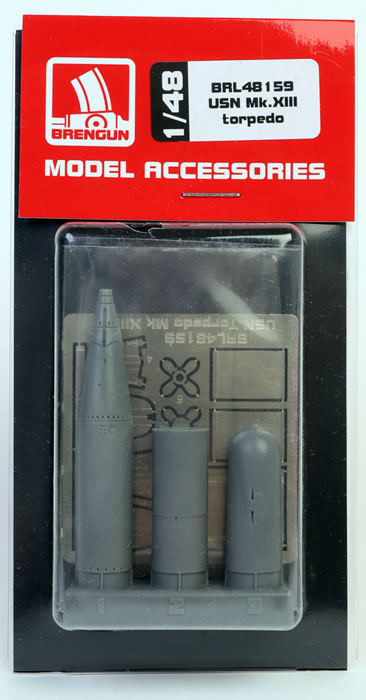
Brengun, 1/48 scale
S u m m a r y : |
Catalogue Number: |
Brengun Item No. BRL48159 - USN Mk.XIII Torpedo |
Scale: |
1/48 |
Contents & Media |
Three grey resin cast parts, a fret of twelve photo-etched parts and instructions. |
Price: |
13.07 € plus shipping available online from Brengun
£11.75 UK Price (£9.79 Export Price) plus shipping available online from Hannants
and specialist hobby retailers worldwide
Click here for currency converter. |
Review Type: |
First Look. |
Advantages: |
Clean moulding with great detail of a much-used torpedo of the US Navy. No seams to clean up, accurate shape and choice of heads used at different periods of the war. The etch parts give great and fine detail but requires some finer assembly. |
Disadvantages: |
None noted. |
Conclusions: |
A very detailed set of the most used USN torpedo of WWII. It will certainly look impressive under your USN torpedo bomber aircraft. |
Reviewed by David Couche

The Mark 13 torpedo was the U.S. Navy's most common aerial torpedo of World War II. It was the first American torpedo to be originally designed for launching from aircraft only. They were also used on PT boats.
Originating in a 1925 design study, the Mark 13 was subject to changing USN requirements through its early years with resulting on-and-off development. Early models—even when dropped low to the water at slow speeds—were prone to running on the surface, or not running at all. By late 1944, the design had been modified to allow reliable drops from as high as 2,400 ft (730 m), at speeds up to 410 knots (760 km/h). The final Mark 13 weighed 2,216 lb (1,005 kg); 600 lb (270 kg) of this was the high explosive Torpex.
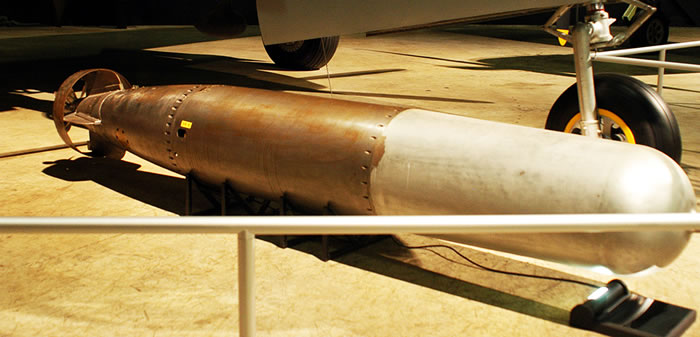
The Mark 13 was designed with unusually squat dimensions for its type: diameter was 22.5 inches (570 mm) and length 13 feet 5 inches (4.09 m). In the water, the Mark 13 could reach a speed of 33.5 knots (62.0 km/h; 38.6 mph) for up to 6,300 yards (5,800 m). The Mark 13 ran 12.8 knots (23.7 km/h; 14.7 mph) slower than the Mark 14 torpedo. 17,000 were produced during the war.
By 1942, poor combat performance had made it apparent that there were problems with the Mark 13, as 35 out of 41 torpedo bombers were lost at the Battle of Midway without scoring a single hit:
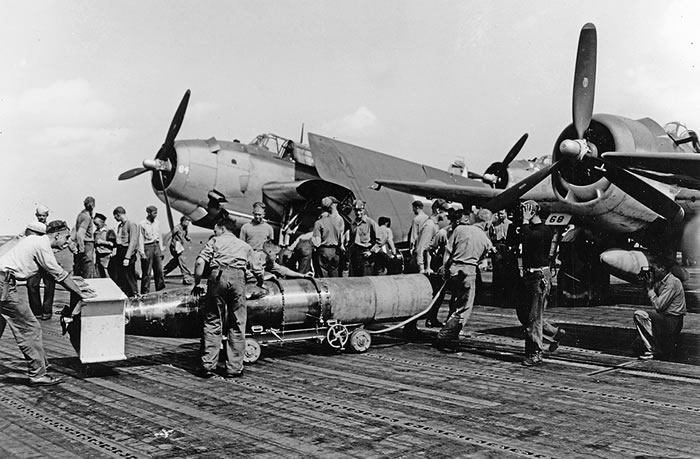
Despite the complications that were attending the other phases of torpedo development, the Bureau of Ordnance considered the aircraft torpedo problem so important that it was assigned the highest priority at the Newport Station. The improvements and modifications of 1942 and 1943 still left the weapon unpopular, however, and production problems were as great as those stemming from incomplete development. In mid-1943 an analysis of 105 torpedoes dropped at speeds in excess of 150 knots (280 km/h) showed clearly why aviators distrusted the Mark 13: 36 percent ran cold, 20 percent sank, 20 percent had poor deflection performance, 18 percent gave unsatisfactory depth performance, 2 percent ran on the surface, and only 31 percent gave a satisfactory run. The total in excess of 100 percent proved that many torpedoes were subject to more than one of the defects, just as the bulk of the problems were still due to the effects of poor air stabilization on water behaviour. Better performance at reduced aircraft speeds was small comfort since aviators could not be held down by paper restrictions that imposed serious and dangerous handicaps in combat. Time promised to complicate the problem still further. Unsatisfactory for existing planes, the torpedo would certainly fail to utilize the potentialities of aircraft then under development. Confronted with such a problem, the Bureau felt that it had two alternatives: it could accept the Mark 13 as an interim weapon with recognized tactical limitations and initiate the design of a new torpedo, or it could concentrate on eliminating the known defects in the existing weapon, which they tried to do.
New planes outdated the Torpedo Mark 13, but drag rings and stabilizers renewed its usefulness. Throughout 1943 torpedo performance remained poor, but the following year witnessed a revolution in the behaviour of the Mark 13. Minor changes to the propeller blades and a reduction in gyro damage helped, but the greatest improvement resulted from the stabilizing effects of two appendages--the drag ring and the shroud ring.
The first assembly, known familiarly as the pickle barrel, was readied for use by 1944 (photo examples above and below). Early experiments with parachutes attached to aircraft torpedoes had demonstrated that a drag had a beneficial effect on the airflight characteristics of the weapon. Constructed of plywood, the ring was attached to the head of a torpedo and served as a stabilizer for the period that the weapon was airborne. Oscillations were reduced and the ring effected a 40 percent deceleration in air speed, then acted as a shock absorber when the torpedo struck water. Better water entry, a by-product of air stabilization, reduced damage so substantially that pilots were able to increase the heights and speeds at which torpedoes were released.
By midsummer 1944, however, the shroud ring developed by the California Institute of Technology completed the torpedo revolution that had seemed so remote the year before. The shroud ring was made to fit over the tail blades of the torpedo. Known to pilots as the ring tail, it produced a steady water run by reducing hooks and broaches and eliminating much of the water roll which characterized the Mark 13. Speed and range were reduced but slightly. Early tests showed that ring-tailed torpedoes took too deep an initial dive, but readjustments of controls soon remedied that last obstacle. Hot, straight, and normal runs approached 100 percent, and the once critical battle reports soon became enthusiastic in praise of the Mark 13. Even psychologically, the appendages contributed to success since the external design of the torpedo equipped with a pickle barrel and ring tail and the improved appearance of its underwater travel caught the fancy of the airmen.
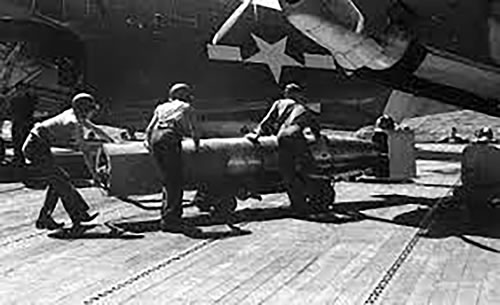
To speed the availability of the modified torpedo the Bureau built tail assemblies with the shroud ring attached, then sent them to the fleet as substitutes for the equipment on hand. By the fall of 1944 the revamped weapon had a wide distribution. As a result of the new improvements, torpedo drops at altitudes up to 800 feet (240 m) and at speeds up to 300 knots (560 km/h) were authorized. Experience soon indicated that these limits could be extended even further. On one occasion in early 1945, 6 Mark 13 torpedoes were released from altitudes between 5,000 and 7,000 feet (1,500 and 2,100 m); 5 out of the 6 were observed to run hot, straight, and normal. Combat use increased rapidly and the new effectiveness seemed out of all proportion to the changes made. On one air strike on April 7, 1945, Mark 13's sent to the bottom the 45,000 ton (sic) battleship Yamato, a light cruiser, and several destroyers. Months before the end of the war the Mark 13 was universally accepted as the best aircraft torpedo owned by any nation.
*Text from Wikipedia
The USN Mk XIII torpedo is supplied in a cardboard backed plastic bag. The 3 resin pieces are on one resin cast block. You have a rear section of the torpedo and a choice of 2 heads, one as a clean version and one with the pickle barrel type head.
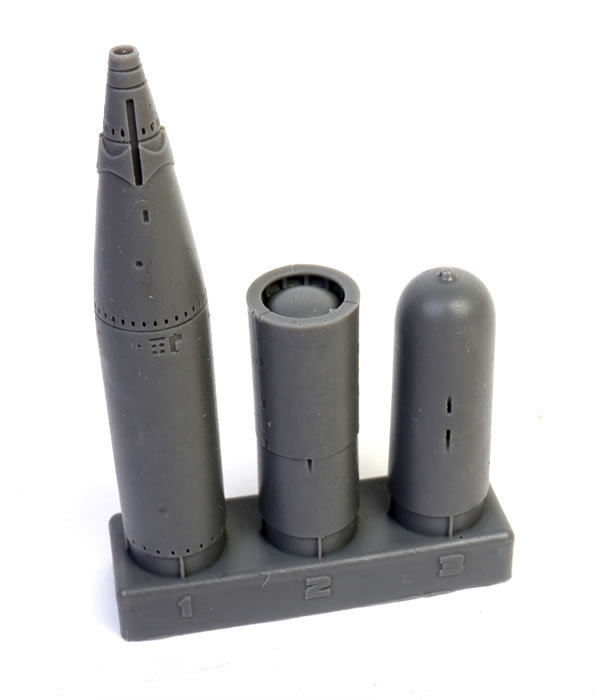
The attachment points are on the flat joining surf and after removal will need only minimum clean up. There are no seam lines where the great body detail is.

The sheet of etched parts covers both the early and late tail versions as well as the simple tail shroud ring. This is where the bulk of your careful construction will occur.
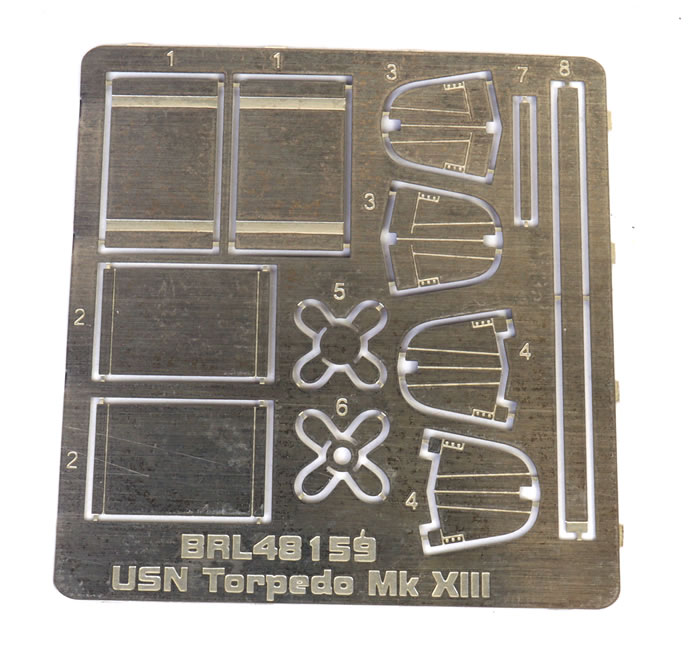
One thing to note is that you will need to make 2 slice cuts in the resin at the propeller end, so you have the 2 spacers between the prop blades. This will require great care to get them straight. The early version, 1935-42, of the Mk XIII just had the tail fins with no additions. The interim version had the ring around the tail fins, which is supplied in photoetch and your will need to roll. The late version, 1943-45, has the plywood tail box section supplied as photoetch parts. The tricky part here is to paint them with a wood finish.
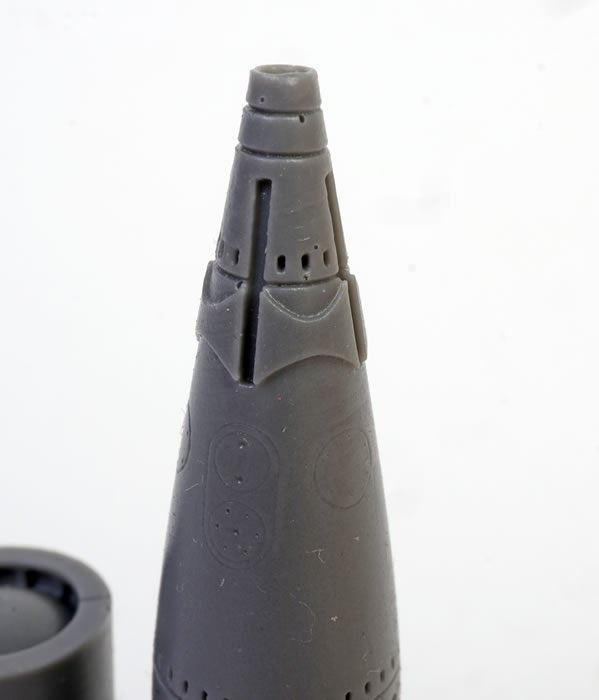
The instructions are on a small sheet with only on step in their construction.

There are generic paint call outs on it but these shouldn’t be a problem with only olive drab, brass, gull grey and wood used.
The Brengun USN Mk XIII torpedo will certainly add some quality detail to your models and provide choices in appearance for the various stages of WWII. This torpedo is suitable for a myriad of different aircraft, such as Devastators, TBF Avengers, B-26 Marauders, Ventura’s, Privateer’s and many others. I will be looking at using this set on a future build of my Midway Devastator, and to use the remaining parts, along with the plastic rear of the kit torpedo to do a late war version for a TBF Avenger build. I would recommend this set for the great detail and relative straight forward construction.
Thanks to Brengun for the review sample.
Review Text Copyright © 2022 David Couche
Images Copyright © 2022 Brett Green
Page Created 25 February, 2022
Last updated
6 April, 2022
Back to HyperScale Main Page
Back to Reviews Page |
